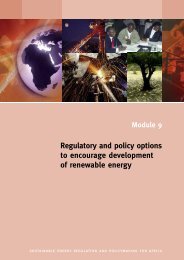Increasing access to energy services in rural areas - REEEP ...
Increasing access to energy services in rural areas - REEEP ...
Increasing access to energy services in rural areas - REEEP ...
Create successful ePaper yourself
Turn your PDF publications into a flip-book with our unique Google optimized e-Paper software.
MODULE 10: INCREASING ACCESS TO ENERGY SERVICES IN RURAL AREAS<br />
page 10.55<br />
10. ANNEX 1 – DETAILS OF THE<br />
MILLENNIUM DEVELOPMENT GOALS<br />
Goals and targets<br />
Goal 1<br />
Goal 2<br />
Goal 3<br />
Goal 4<br />
Goal 5<br />
Goal 6<br />
Eradicate extreme poverty and hunger<br />
Indica<strong>to</strong>rs<br />
Target 1: Halve, between 1990 and 2015, 1(a). Proportion of population below $1 a day<br />
the proportion of people whose <strong>in</strong>come 1(b). National poverty headcount ratio<br />
is less than $1 a day<br />
2. Poverty gap ratio at $1 a day<br />
(<strong>in</strong>cidence x depth of poverty)<br />
3. Share of poorest qu<strong>in</strong>tile <strong>in</strong> national<br />
consumption<br />
Target 2: Halve, between 1990 and 2015, 4. Prevalence of underweight <strong>in</strong> children<br />
the proportion of people who suffer (under five years of age)<br />
from hunger<br />
5. Proportion of population below m<strong>in</strong>imum<br />
level of dietary <strong>energy</strong> consumption<br />
Achieve universal primary education<br />
Target 3: Ensure that, by 2015, children 6. Net enrolment ratio <strong>in</strong> primary education<br />
everywhere, boys and girls alike, will 7(a). Proportion of pupils start<strong>in</strong>g grade 1<br />
be able <strong>to</strong> complete a full course of who reach grade 5<br />
primary school<strong>in</strong>g<br />
7(b.) Primary completion rate<br />
8. Literacy rate of 15 <strong>to</strong> 24-year-olds<br />
Promote gender equality and empower women<br />
Target 4: Elim<strong>in</strong>ate gender disparity <strong>in</strong> 9. Ratio of girls <strong>to</strong> boys <strong>in</strong> primary,<br />
primary and secondary education secondary, and tertiary education<br />
preferably by 2005 and <strong>in</strong> all levels of 10. Ratio of literate females <strong>to</strong> males<br />
education no later than 2015<br />
among 15- <strong>to</strong> 24-year-olds<br />
11. Share of women <strong>in</strong> wage employment<br />
<strong>in</strong> the non-agricultural sec<strong>to</strong>r<br />
12. Proportion of seats held by women <strong>in</strong><br />
national parliament<br />
Reduce child mortality<br />
Target 5: Reduce by two-thirds,<br />
13. Under-five mortality rate<br />
between 1990 and 2015, the under-five 14. Infant mortality rate<br />
mortality rate<br />
15. Proportion of one-year-old children<br />
immunized aga<strong>in</strong>st measles<br />
Improve maternal health<br />
Target 6: Reduce by three-quarters, 16. Maternal mortality ratio<br />
between 1990 and 2015, the maternal 17. Proportion of births attended by skilled<br />
mortality ratio<br />
health personnel<br />
Combat HIV/AIDS, malaria, and other diseases<br />
Target 7: Have halted by 2015 and 18. HIV prevalence among 15- <strong>to</strong> 24-year-old<br />
begun <strong>to</strong> reverse the spread of HIV/AIDS pregnant women<br />
19. Condom use rate of the contraceptive<br />
prevalence rate<br />
19(a). Condom use at last high-risk sex<br />
19(b). Percentage of population aged 15-24<br />
with comprehensive correct knowledge of<br />
HIV/AIDS<br />
19(c). Contraceptive prevalence rate<br />
20. Ratio of school attendance of orphans<br />
<strong>to</strong> school attendance on non-orphans aged<br />
10-14










